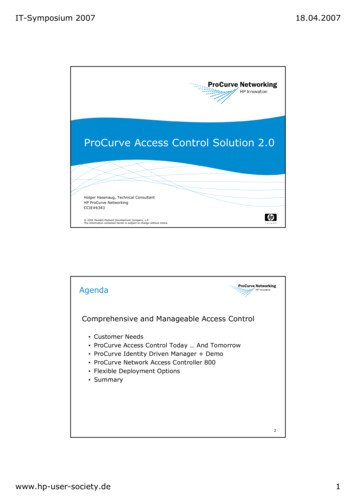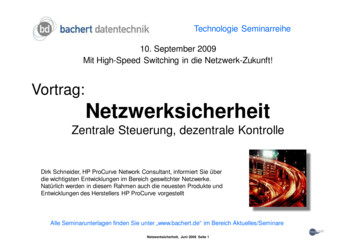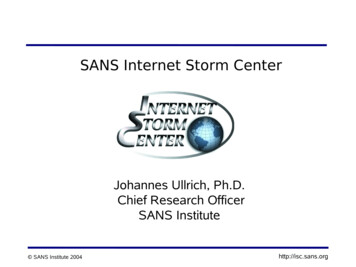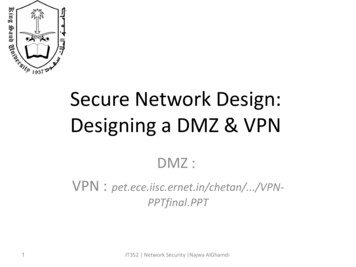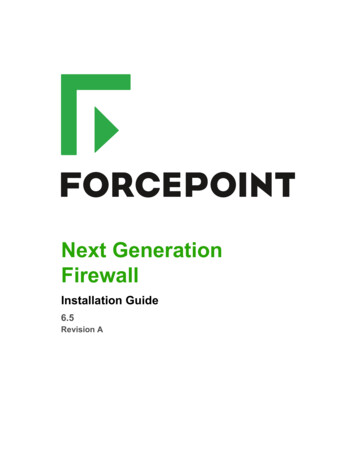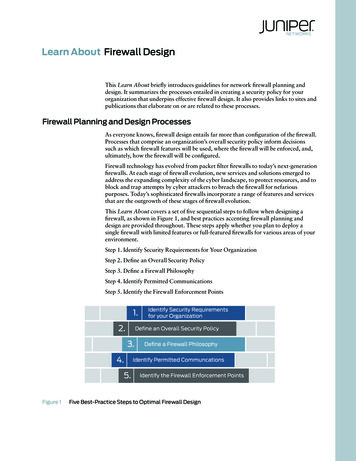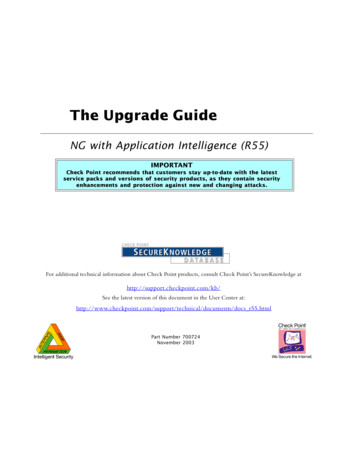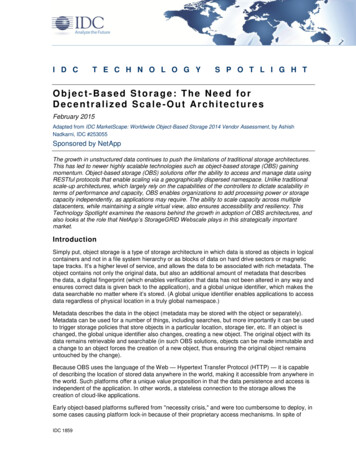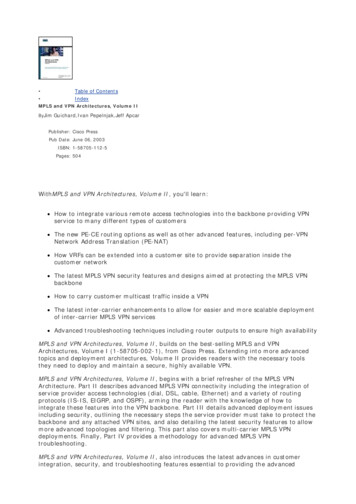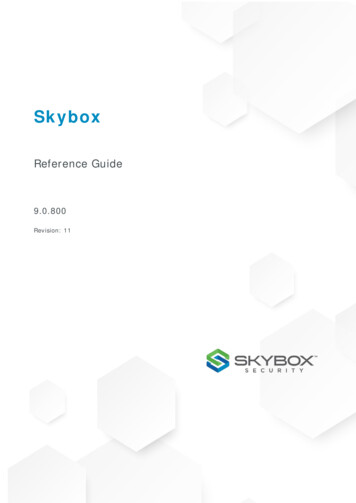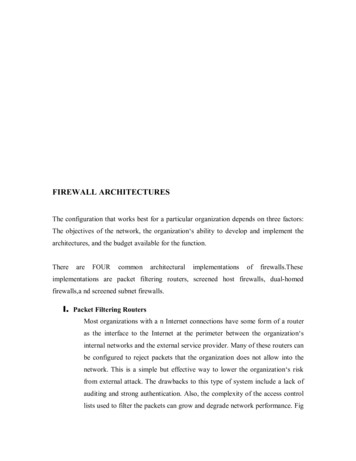
Transcription
FIREWALL ARCHITECTURESThe configuration that works best for a particular organization depends on three factors:The objectives of the network, the organization‘s ability to develop and implement thearchitectures, and the budget available for the tionsoffirewalls.Theseimplementations are packet filtering routers, screened host firewalls, dual-homedfirewalls,a nd screened subnet firewalls.I. Packet Filtering RoutersMost organizations with a n Internet connections have some form of a routeras the interface to the Internet at the perimeter between the organization‘sinternal networks and the external service provider. Many of these routers canbe configured to reject packets that the organization does not allow into thenetwork. This is a simple but effective way to lower the organization‘s riskfrom external attack. The drawbacks to this type of system include a lack ofauditing and strong authentication. Also, the complexity of the access controllists used to filter the packets can grow and degrade network performance. Fig
6-4 is an example of this type of architecture.II. Screened Host FirewallsThis architecture combines the packet filtering router with a separate, dedicatedfirewall, such as an application proxy server. This approach allows the router topre-screen packets to minimize the network traffic and loads on the internalproxy.The application proxy examines an application layer protocol, such asHTTP, and perform the proxy services. This separate host is often referred to as abastion host; it can be a rich target for external attacks, and should be verythoroughly secured.Evn though the bastion host/application proxy actuallycontains only cached copies of the internal Web documents, it can still present apromising target, because compromise of the bastion host can disclose theconfiguration of internal networks and possibly provide external sources withinternal information. Since the bastion host stands as a sloe defender on thenetwork perimeter, it is also commonly referred to as the Sacrificial Host.To its advantage, this configuration requires the external attack to compromisetwo separate systems, before the attack can access internal data. Inthis way, thebastion host protects the data more fully than the router alone. Fig 6-11 shows atypical configuration of a screened host architectural approach.
III.Dual-Homed Host FirewallsThe next step up in firewall architectural complexity is the dual-homed host. When thisarchitectural approach is used, the bastion host contains two NICs (Network InterfaceCards) rather than one, as in the bastion host configuration. One NIC is connected to theexternal network, and one is connected to the internal network, providing an additionallayer of protection. With TWO NICs , all traffic must physically go through the firewallto move between the internal and external networks.Implementation of this architecture often makes use of NATs. NAT is a method ofmapping real, valid, external IP addresses to special ranges of non-routable internal IPaddresses, thereby creating yet another barrier to intrusion from external attackers.The internal addresses used by NAT consist of three different ranges. Organizations thatneed Class A addresses can use the 10.x.x.x range, which has over 16.5 million usableaddresses. Organization‘s that need Class B addresses can use the 192.168.x.x range,which has over 65,500 addresses. Finally , organiazations with smaller needs , such asthose needing onlya few Class C addresses, can use the c172.16.0.0 to 172.16.15.0 range,which hs over 16 Class C addresses or about 4000 usable addresses.See table 6-4 for a recap of the IP address ranges reseved fro non-public networks.Messages sent with internal addresses within these three internal use addresses is directlyconnected to the external network, and avoids the NAT server, its traffic cannot be routedon the public network. Taking advantage of this , NAT prevents external attacks fromreaching internal machines with addresses in specified ranges.If the NAT server is amulti-homed bastion host, it translates between the true, external IP addresses assigned tothe organization by public network naming authorities ansd the internally assigned, nonroutable IP addresses. NAT translates by dynamically assigning addresses to internalcommunications and tracking the conversions with sessions to determine which incomingmessage is a response to which outgoing traffic. Fig 6-12 shows a typical configurationof a dual homed host firewall that uses NAT and proxy access to protect the internalnetwork.
Another benefit of a dual-homed host is its ability to translate betweenmany different protocols at their respective data link layers, including Ethernet , TokenRing, Fiber Distributed Data interface (FDDI) , and Asynchronous Transfer Method(ATM). On the downside, if this dual-homed host is compromised, it can disable theconnection to the external network, and as traffic volume increases, it can become overloaded. Compared to more complex solutions, however, this architecture provides strongoverall protection with minimal expense.IV.Screened Subnet Firewalls (with DMZ)The dominant architecture used today is the screened subnet firewall. The architecture ofa screened subnet firewall provides a DMZ. The DMZ can be a dedicated port on thefirewall device linking a single bastion host, or it can be connected to a screened subnet,as shown in Fig 6-13. Until recently , servers providing services through an untrustednetwork were commonly placed in the DMZ. Examples of these include Web servers, filetransfer protocol (FTP) servers, and certain database servers. More recent strategies usingproxy servers have provided much more secure solutions.
A common arrangement finds the subnet firewall consisting of two or more internalbastion hosts behind a packet filtering router, with each host protecting the trustednetwork. There are many variants of the screened subnet architecture. The first generalmodel consists of two filtering routers, with one or more dual-homed bastion hostsbetween them. In the second general model, as illustrated in Fig 6-13 , the connectionsare routed as follows:1.Connections from the outside or un trusted network are routed through anexternal filtering router.2.Connections from the outside or un trusted network are routed into-and thenout of – a routing firewall to the separate network segment known as the DMZ.3.Connections into the trusted internal network are allowed only from theDMZ bastion host servers.
The screened subnet is an entire network segment that performs two functions: it protectsthe DMZs systems and information from outside threats by providing a network ofintermediate security; and it protects the internal networks by limiting how externalconnections can gain access to internal systems. Although extremely secure, the screenedsubnet can be expensive to implement and complex to configure and manage. The valueof the information it protects must justify the cost.Another facet of the DMZ is the creation of an area of known as an extranet. AN extranetis a segment of the DMZ where additional authentication and authorization controls areput into place to provide services that are not available to the general public. An examplewould be an online retailer that allows anyone to browse the product catalog and placeitems into a shopping cart, but will require extra authentication and authorization whenthe customer is ready to check out and place an order.Source : notes.pdf
a screened subnet firewall provides a DMZ. The DMZ can be a dedicated port on the firewall device linking a single bastion host, or it can be connected to a screened subnet, as shown in Fig 6-13. Until recently , servers providing services through an untrusted network were commonly placed in the DMZ. Examples of these include Web servers, file
